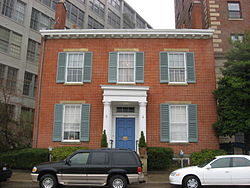Lytle Park
|
Lytle Park Historic District
|
|

Literary Club building
|
|
| Location | Roughly bounded by 3rd, 5th, Sycamore, Commercial Sq., and Butler Sts., Cincinnati, Ohio |
|---|---|
| Coordinates | 39°6′4″N 84°30′19″W / 39.10111°N 84.50528°WCoordinates: 39°6′4″N 84°30′19″W / 39.10111°N 84.50528°W |
| Area | 50 acres (20 ha) |
| Architectural style | Greek Revival, Italianate, Georgian |
| NRHP reference # | 76001435 |
| Added to NRHP | March 26, 1976 |
Lytle Park Historic District is a historic district in Cincinnati, Ohio, United States. Roughly bounded by 3rd, 5th, Sycamore, Commercial Sq., and Butler Sts. in downtown Cincinnati, it centers on Lytle Park.
In 2014, Western & Southern Financial Group, owner of many properties within the Lytle Park Historic District asked the city to remove historic status of several historic buildings. The company hopes to demolish sections of the district in order to build new office space.
Lytle Park has a storied history and represents one of the oldest areas in the city. Originally a hardwood forest, the park and its vicinity was the early site of Fort Washington, built in 1789 to protect early settlers of the Ohio River town from Indian attacks.
The site next served as the homestead of the prominent Lytle family. Surveyor General of the Northwest Territory William Lytle II built his house there in 1809, about ten years prior to the completion of the neighboring Martin Baum mansion (now the Taft Museum of Art). The land then known as Lytle Square was purchased by the City of Cincinnati in 1905 and Lytle Park was dedicated July 6, 1907.
The 11-foot (3.4 m) bronze statue of Abraham Lincoln facing the entrance of the park was commissioned by the Charles P. Taft family. The unusually beardless statue is the only public monument to an individual ever produced by sculptor George Grey Barnard. The statue was dedicated amid great fanfare on March 31, 1917, by former president William Howard Taft. The adjacent U.S. Marine Corps Memorial is a granite boulder with bronze plaque and Marine emblem atop a globe. It was dedicated in 1921.
...
Wikipedia


